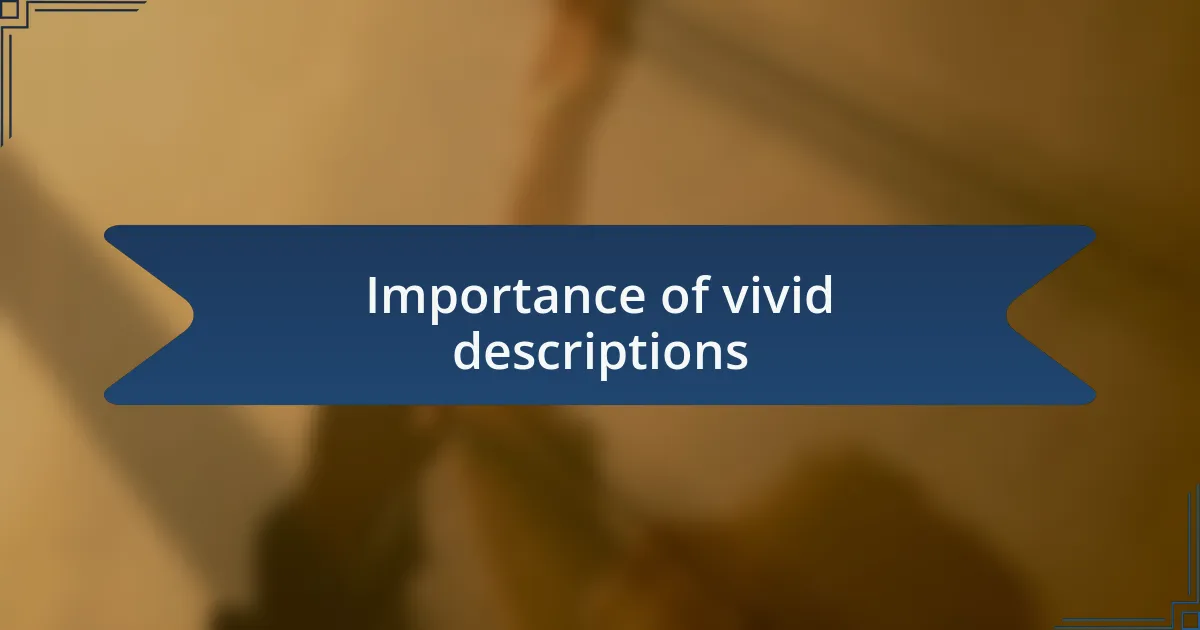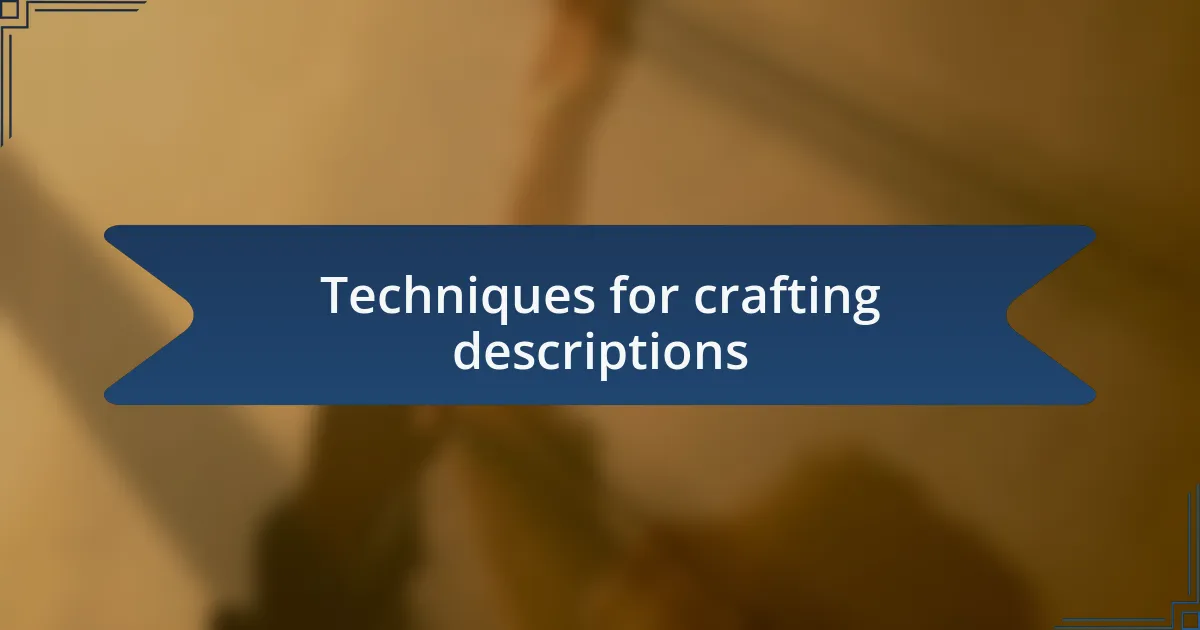Key takeaways:
- Vivid descriptions enhance storytelling by creating emotional connections and immersing readers in the narrative.
- Techniques such as sensory details, metaphor, and character reactions deepen the impact of descriptions.
- Analyzing Agatha Christie’s style reveals her mastery of setting and character portrayal, making environments integral to the story.
- Improving descriptions involves engaging all senses, using strong verbs, and reflecting characters’ emotions to enrich the narrative.

Understanding vivid descriptions
Vivid descriptions serve as the brushstrokes in the canvas of storytelling, painting scenes that linger in the reader’s imagination. When I read Agatha Christie’s works, I often find myself so engrossed in the details—like the scent of a freshly lit cigarette lingering in the detective’s study or the way the rain tapped against a window. Have you ever felt transported by a single phrase?
Why do some descriptions stick with you while others fade away? It’s often about the specific details that resonate emotionally. I recall analyzing how Christie webbed emotion into her descriptions, like the palpable tension in a room before a reveal, making everything feel more immediate and urgent. This kind of specificity pulls readers closer, drawing them into the experience rather than just observing it from a distance.
Understanding how each word can evoke a feeling or an image is crucial. For instance, I remember crafting a vivid description of an old, creaking staircase that felt haunted. I used sensory details—the groans of the wood, the lingering chill in the air—to create an atmosphere. This technique connects readers to the narrative on a deeper level, turning a simple scene into an unforgettable moment.

Importance of vivid descriptions
Vivid descriptions are essential because they transform ordinary scenes into extraordinary experiences. I remember being captivated by a moment in “Murder on the Orient Express,” where the train itself felt like a character, with its plush velvet seats and the muted clatter of the wheels on the tracks. Don’t you think such details make a story not just read but felt?
When descriptions evoke strong sensory experiences—like the warmth of a cozy fire or the sharp bite of cold air—readers can truly immerse themselves in the narrative. I once crafted a passage about a dimly lit room filled with dusty books, and I could almost smell the aged paper. That immediate connection is what makes storytelling come alive. How can words evoke memories and emotions we didn’t even know we had?
The importance of vivid descriptions lies in their ability to foster connections between the reader and the characters’ journeys. Reflecting on my own writing, I’ve found that when I focus on the small, often overlooked details, it creates a shared space between me and the reader. It’s like inviting someone into my own world, where they can experience the story alongside me. Isn’t that the magic of storytelling—making readers feel as if they are part of the journey?

Techniques for crafting descriptions
To craft effective descriptions, I rely heavily on the power of imagery. When I think back to a scene I wrote about a bustling marketplace, I focused on the riot of colors and sounds: the vivid oranges of ripe fruits and the sharp calls of vendors competing for attention. This technique not only captures the setting but invites readers to visualize and feel the energy of the place. Have you ever found yourself lost in a vivid description so much that you could almost hear the chaos?
Another technique I embrace is using metaphor and simile. For instance, describing a stormy sky as “the heart of an angry beast” instantly conveys ferocity and intensity. This approach ignites the imagination—it creates a visceral response. In my writing, I’ve noticed that when I draw these comparisons, it humanizes the elements of nature, making them resonate more deeply with readers. Isn’t it fascinating how our language can evoke such strong emotions?
Lastly, I find that incorporating character reactions adds depth to a description. When I wrote a scene about a character walking through a fog-shrouded graveyard, I portrayed their trepidation and shudder as the mist curled around them. This layering of emotion not only enhances the vividness of the place but also draws the reader closer to the character’s experience. How can a reader feel the chill if we don’t let them glimpse a character’s fear?
Analyzing Agatha Christie’s style
Agatha Christie’s writing style is marked by her ability to convey rich atmospheres with careful attention to detail, often through the eyes of her characters. I remember the first time I read “Murder on the Orient Express.” The way Christie described the opulent train and its passengers gave me the sensation of being on board, sipping champagne as the snowflakes danced outside. It’s a perfect example of how she creates a sense of place so vividly that it almost becomes a character itself. Can you recall a moment in her writing where the setting felt palpable, almost breathing alongside the action?
In my observation, Christie masterfully balances straightforward prose with layered meanings. One moment she might be detailing a quaint English village, and the next, she reveals the underlying tensions that pulse just beneath the surface. It reminds me of the way I explored an idyllic garden in my own writing, only to have it transform into a backdrop for darker secrets. This duality in settings captivates the reader, forcing them to question what lies beneath the surface. Have you ever found yourself wondering about the secrets hidden in a seemingly perfect place?
Moreover, her distinctive character portrayal adds significant depth to her vivid descriptions. When I read about Hercule Poirot’s meticulous habits and unique observations, it struck me how these traits bring the surrounding environment to life. I’ve tried emulating this in my own work, particularly when describing fragmented lives in a bustling city. By connecting a character’s quirks to their surroundings, I help the reader see the world through their eyes. Isn’t it compelling to consider how our characters shape our perception of their world?

Personal experiences with vivid writing
When I first attempted to craft vivid descriptions in my writing, I found inspiration in the way Christie captured emotions through environments. I recall a short story I wrote about a stormy night in a small seaside town. The howling wind and crashing waves became metaphors for the protagonist’s inner turmoil. I saw the setting not just as a backdrop but as a reflection of my character’s feelings. Have you ever noticed how the right scene can evoke a sense of dread or hope?
There was an instance during a writing workshop when we were encouraged to describe a mundane object in extraordinary detail. I chose an old, rusty key that belonged to my grandmother. As I described the intricate designs and the stories it held, I could see my peers’ eyes widen with intrigue. They weren’t just hearing about a key; they were envisioning its history and significance. Isn’t it interesting how a simple object can weave a rich narrative?
In crafting character descriptions, I often draw from my own experiences. I once depicted a friend whose laughter echoed like bells in a quiet room. By juxtaposing her vibrant personality with the stillness around her, I created a striking image that left a lasting impression. It’s moments like these that remind me how the energy of a character can infuse life into the surrounding details. What memorable characters have left an imprint on your imagination through their vivid portrayals?
Examples from Agatha Christie’s work
Agatha Christie masterfully employs vivid descriptions to enhance her narratives, often making settings integral to the story’s mood. In “Murder on the Orient Express,” the lavish train becomes more than just a backdrop; it transforms into a microcosm of intrigue where the atmosphere pulses with tension and luxury. When I read this, I felt as if I were on board, enveloped by the sights and sounds, which heightened my sense of anticipation. Have you ever felt like an active participant in a story because of how vividly the setting is portrayed?
In “And Then There Were None,” Christie’s descriptions of the isolated island contribute significantly to the sense of unease. Each character’s growing paranoia is mirrored in the stark and foreboding landscape, enhancing the chilling anticipation of betrayal. I remember feeling a surge of anxiety as I read about the craggy cliffs and crashing waves, amplifying the book’s suspense. How powerful can a well-crafted landscape be in conveying emotional undercurrents in a story?
Furthermore, Christie’s talent for character descriptions often reveals their inner workings through subtle details. For example, Hercule Poirot’s meticulous nature is reflected in the precise way he examines a crime scene, from the placement of objects to the clever constructs of people’s interactions. Reading through these passages reminds me of how personal traits can be beautifully illustrated through actions. Have you noticed how a character’s quirks can create a deeper connection to their story?

Tips for improving your descriptions
When I think about improving descriptions, one key tip is to engage all five senses. Instead of merely stating what something looks like, I ask myself how it smells, sounds, and feels. For instance, when I describe a bustling marketplace, I focus on the vibrant colors of fruit stalls, the distant chatter of vendors, and the fragrant spices wafting through the air. Can you imagine how much richer a scene becomes when you allow readers to experience it fully?
Another effective strategy is to use strong verbs and specific nouns. I often find that choosing a word like “sprinted” instead of “ran” instantly injects energy into a description. It’s all about choosing language that paints a clearer picture. You’ll find that well-chosen words resonate more deeply; have you noticed how certain phrases stick with you long after you’ve read them?
Lastly, consider the emotional landscape of your characters as you weave your descriptions. I enjoy exploring how a character’s feelings can transform a setting. For example, a sunny day might feel oppressive to someone in mourning, while it could exhilarate another celebrating a new beginning. Don’t you think this depth adds layers to your storytelling, making it more relatable and impactful?